
A tree may explode when stresses in its trunk increase due to extreme cold, heat, or lightning, causing it to split suddenly.

A tree may explode when stresses in its trunk increase due to extreme cold, heat, or lightning, causing it to split suddenly.
Cold weather will cause some trees to shatter by freezing the sap, because it contains water, which expands as it freezes, creating a sound like a gunshot. [1] [2] The sound is produced as the tree bark splits, with the wood contracting as the sap expands. [2] [3] John Claudius Loudon described this effect of cold on trees in his Encyclopaedia of Gardening, in the entry for frosts, as follows: 1
The history of frosts furnishes very extraordinary facts. The trees are often scorched and burnt up, as with the most excessive heat, in consequence of the separation of water from the air, which is therefore very drying. In the great frost in 1683, the trunks of oak, ash, walnut, and other trees, were miserably split and cleft, so that they might be seen through, and the cracks often attended with dreadful noises like the explosion of fire-arms. In the frost of 1837–8 large bushes of heath had their stems split by the frost into shreds, and the wood of the evergreen oak and that of the sweet bay was cracked and split in a similar manner.
Henry Ward Beecher records anecdotal evidence of the wood from which instrument cases and carrying boxes were splitting in temperatures of −70 °F (−57 °C) in Captain Bach's travels near the Great Slave Lake. [4] Linda Runyon, author of books on wilderness living, recounts her experience of the effect of cold on maple trees as follows:
I was relaxing in front of a fire in the crispness of early morning when Crack! A sound like an explosion came from behind me in the woods. I scanned the trees and saw that a maple tree had "exploded". The explosion caused a big crack in the tree about three feet high. When a winter wind stirs the frozen trees, they sometimes appear to burst vertically. When it was 40 degrees below zero at night, I lay awake and listened to the trees explode. That's a true wilderness thermometer!
— Linda Runyon, The Essential Wild Food Survival Guide [6]
Wally and Shirley Loudon reported the effect of the freeze of December 1968 upon their orchard in Carlton, Washington as follows: [3]
We saw 47 below on our porch, and we didn't look again. I would hear these bangs and I blamed it on the house expanding or contracting, or whatever, from the cold, but it was the trees exploding. It was the bark bursting, and you could hear it. That's how wild it was.
To the Sioux of The Dakotas and the Cree, the first new moon of the new year is known, in various dialects, as the "Moon of the Cold-Exploding Trees". [8] [9] [10] [11]
Tree sap is a supercooled liquid in cold temperatures. [12] John Hunter observed, in his Treatise on the Blood, that tree sap within a tree freezes some 17 degrees Fahrenheit below its nominal freezing point. [13] [14]
Trees can explode when struck by lightning. [3] [15] [16] [17] The strong electric current is carried mostly by the water-conducting sapwood below the bark, heating it up and boiling the water. The pressure of the steam can make the trunk burst. [3] [17] This happens especially with trees whose trunks are already dying or rotting. [3] [18] [19] The more usual result of lightning striking a tree, however, is a lightning scar, running down the bark, or simply root damage, whose only visible sign above ground is branches that were fed by the root dying back. [17] [20]
Exploding trees also occur during forest fires [21] and are a risk to smokejumpers. [22] [23] [24]
Eucalyptus trees are known to explode during bush fires due to vaporised eucalyptus oils producing an explosive mixture with air. [25] [26] [27] [28] [29]
Explosive behaviour of Eucalyptus trunks has been observed in both laboratory tests and in wildfires in Australia. [30]
Aspen trees have also been observed to explode in wildfires. [31]
Steam pressure build up in tree trunks is theoretically unlikely to lead to an explosion in a rapidly moving fire front, although trees exploding after the initial front has passed or exploding through other mechanisms is entirely possible. [32]
Exploding trees were the subject of a 2005 April Fools' Day hoax in the United States, covered by National Public Radio, stating that maple trees in New England had been exploding due to a failure to collect their sap, causing pressure to build from the inside. [33] The root pressure in a maple tree is approximately 0.1 MPa, one standard atmosphere, which is insufficient to cause a tree to explode. [3] [34]
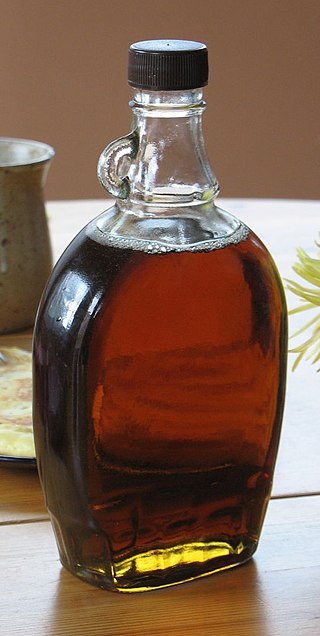
Maple syrup is a syrup made from the sap of maple trees. In cold climates, these trees store starch in their trunks and roots before winter; the starch is then converted to sugar that rises in the sap in late winter and early spring. Maple trees are tapped by drilling holes into their trunks and collecting the sap, which is processed by heating to evaporate much of the water, leaving the concentrated syrup.

Eucalyptus is a genus of more than 700 species of flowering plants in the family Myrtaceae. Most species of Eucalyptus are trees, often mallees, and a few are shrubs. Along with several other genera in the tribe Eucalypteae, including Corymbia and Angophora, they are commonly known as eucalypts or "gum trees". Plants in the genus Eucalyptus have bark that is either smooth, fibrous, hard, or stringy and leaves that have oil glands. The sepals and petals are fused to form a "cap" or operculum over the stamens, hence the name from Greek eû ("well") and kaluptós ("covered"). The fruit is a woody capsule commonly referred to as a "gumnut".
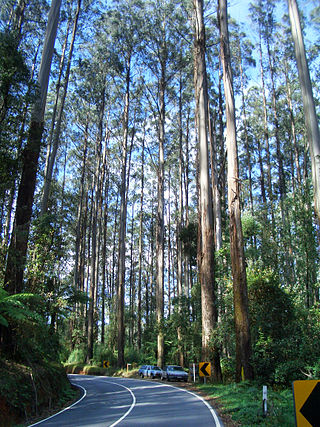
Eucalyptus regnans, known variously as mountain ash, giant ash or swamp gum, or stringy gum, is a species of very tall forest tree that is native to the Australia states of Tasmania and Victoria. It is a straight-trunked tree with smooth grey bark, but with a stocking of rough brown bark at the base, glossy green, lance-shaped to curved adult leaves, flower buds in groups of between nine and fifteen, white flowers, and cup-shaped or conical fruit. It is the tallest of all flowering plants; the tallest measured living specimen, named Centurion, stands 100 metres tall in Tasmania.

Bark is the outermost layer of stems and roots of woody plants. Plants with bark include trees, woody vines, and shrubs. Bark refers to all the tissues outside the vascular cambium and is a nontechnical term. It overlays the wood and consists of the inner bark and the outer bark. The inner bark, which in older stems is living tissue, includes the innermost layer of the periderm. The outer bark on older stems includes the dead tissue on the surface of the stems, along with parts of the outermost periderm and all the tissues on the outer side of the periderm. The outer bark on trees which lies external to the living periderm is also called the rhytidome.

Acer saccharinum, commonly known as silver maple, creek maple, silverleaf maple, soft maple, large maple, water maple, swamp maple, or white maple, is a species of maple native to the eastern and central United States and southeastern Canada. It is one of the most common trees in the United States.
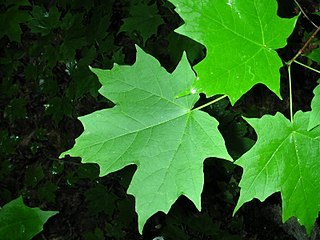
Acer saccharum, the sugar maple, is a species of flowering plant in the soapberry and lychee family Sapindaceae. It is native to the hardwood forests of eastern Canada and the eastern United States. Sugar maple is best known for being the primary source of maple syrup and for its brightly colored fall foliage. It may also be called "rock maple," "sugar tree," "sweet maple," or, particularly in reference to the wood, "hard maple," "birds-eye maple," or "curly maple," the last two being specially figured lumber.

Acer rubrum, the red maple, also known as swamp maple, water maple, or soft maple, is one of the most common and widespread deciduous trees of eastern and central North America. The U.S. Forest Service recognizes it as the most abundant native tree in eastern North America. The red maple ranges from southeastern Manitoba around the Lake of the Woods on the border with Ontario and Minnesota, east to Newfoundland, south to Florida, and southwest to East Texas. Many of its features, especially its leaves, are quite variable in form. At maturity, it often attains a height around 30 m (100 ft). Its flowers, petioles, twigs, and seeds are all red to varying degrees. Among these features, however, it is best known for its brilliant deep scarlet foliage in autumn.

Acer pseudoplatanus, known as the sycamore in the British Isles and as the sycamore maple in the United States, is a species of maple native to Central Europe and Western Asia. It is a large deciduous, broad-leaved tree, tolerant of wind and coastal exposure.
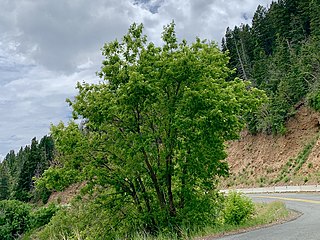
Acer negundo, also known as the box elder, boxelder maple, Manitoba maple or ash-leaved maple, is a species of maple native to North America from Canada to Honduras. It is a fast-growing, short-lived tree with opposite, ash-like compound leaves. It is sometimes considered a weedy or invasive species, and has been naturalized throughout much of the world, including South America, Australia, New Zealand, South Africa, much of Europe, and parts of Asia.

Fagus grandifolia, the American beech or North American beech, is the only species of beech native to North America. Its current range comprises the eastern United States, isolated pockets of Mexico and southeastern Canada. Prior to the glacial maximum of the Pleistocene epoch, the tree flourished over most of North America, reaching California.

Betula papyrifera is a short-lived species of birch native to northern North America. Paper birch is named after the tree's thin white bark, which often peels in paper-like layers from the trunk. Paper birch is often one of the first species to colonize a burned area within the northern latitudes, and is an important species for moose browsing. Primary commercial uses for paper birch wood are as boltwood and sawlogs, while secondary products include firewood and pulpwood. It is the provincial tree of Saskatchewan and the state tree of New Hampshire.

Betula alleghaniensis, the yellow birch, golden birch, or swamp birch, is a large tree and an important lumber species of birch native to northeastern North America. Its vernacular names refer to the golden color of the tree's bark. In the past its scientific name was Betula lutea, the yellow birch.
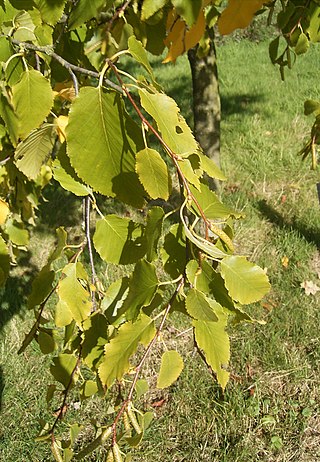
Betula lenta is a species of birch native to eastern North America.

Ironbark is a common name of a number of species in three taxonomic groups within the genus Eucalyptus that have dark, deeply furrowed bark.

Acer is a genus of trees and shrubs commonly known as maples. The genus is placed in the soapberry family Sapindaceae. There are approximately 132 species, most of which are native to Asia, with a number also appearing in Europe, northern Africa, and North America. Only one species, Acer laurinum, extends to the Southern Hemisphere. The type species of the genus is the sycamore maple Acer pseudoplatanus, one of the most common maple species in Europe. Most maples usually have easily identifiable palmate leaves and all share distinctive winged fruits. The closest relative of the maples is the small east Asian genus Dipteronia, followed by the more widespread genus Aesculus. Maple syrup is made from the sap of some maple species. It is one of the most common genera of trees in Asia. Many maple species are grown in gardens where they are valued for their autumn colour and often decorative foliage, some also for their attractive flowers, fruit, or bark.

In botany, a tree is a perennial plant with an elongated stem, or trunk, usually supporting branches and leaves. In some usages, the definition of a tree may be narrower, including only woody plants with secondary growth, plants that are usable as lumber or plants above a specified height. In wider definitions, the taller palms, tree ferns, bananas, and bamboos are also trees.

Psaltoda moerens, commonly known as the redeye, is an Australian species of cicada. It is distributed through the south-east of Australia, from southern Queensland to South Australia, as well as Tasmania. Populations can vary greatly between years; one year they may be present in large numbers and the next they may be entirely absent. They feed primarily on eucalyptus but also on Angophora trees. As they feed on tree sap they expel small droplets of clear waste fluid. When numbers are high, this can form a constant stream.

Frost crack or Southwest canker is a form of tree bark damage sometimes found on thin barked trees, visible as vertical fractures on the southerly facing surfaces of tree trunks. Frost crack is distinct from sun scald and sun crack and physically differs from normal rough-bark characteristics as seen in mature oaks, pines, poplars and other tree species.

Wildfires are outdoor fires that occur in the wilderness or other vast spaces. Other common names associated with wildfires are brushfire and forest fire. Since wildfires can occur anywhere on the planet, except for Antarctica, they pose a threat to civilizations and wildlife alike. In terms of emergency management, wildfires can be particularly devastating. Given their ability to destroy large areas of entire ecosystems, there must be a contingency plan in effect to be as prepared as possible in case of a wildfire and to be adequately prepared to handle the aftermath of one as well.
{{cite journal}}: Cite journal requires |journal= (help){{cite journal}}: Missing or empty |title= (help){{cite journal}}: Cite journal requires |journal= (help){{cite encyclopedia}}: CS1 maint: archived copy as title (link)